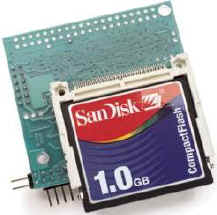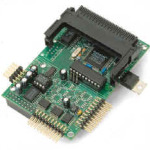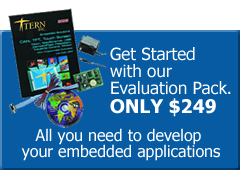Measuring only 2.1″ by 2.35″, the FlashCore-B ($69, qty 100) is a variant of the 186-generation programmable core, now improved to also support data-logging applications.
With the integrated CompactFlash drive (using cards up to 2 GB in size), the FlashCore-B can add an entire new dimension to your embedded application.
With the FB, your equipment becomes truly stand-alone. With FAT filesystem support (and 16-bit ADC/DAC), accessing your data is as easy as plugging the card directly into a CompactFlash drive on your PC/PDA.
Measuring 2.1 x 2.35 inches, the FlashCore-B from TERN provides a simple interface for a 50-pin CompactFlash (CF) Card. These CF cards, ranging in size from 8MB-4 GB, are used to provide non-volatile storage in a wide array of applications, including digital cameras and Personal Data Assistant (PDAs).
The 50-pin CF cards can also interface with PCs via a standard 50-68 pin PCMCIA adapter, or via special CompactFlash-compatible drives (available from SanDisk, for example) making these ideal storage solutions for applications requiring mass data exchange; all of this is available at a significantly lower cost than the 68-pin PCMCIA cards.
With the FlashCore, your embedded application can easily take advantage of the large storage capacity and fast access times of a CompactFlash Card for a range of mass data storage applications. The FlashCore can be used to store vast amounts of data, which can be later processed, transferred over the serial port, or directly accessed by a PC as files on the CF-card.
The FB includes a Am188ES based CPU system. It is a complete standalone C/C++ programmable embedded controller including a 188 CPU, 512KB ACTF Flash, up to 512KB SRAM, 512-byte EEPROM, 2 channel RS-232 drivers and a 5V linear voltage regulator, optional real-time clock, and battery
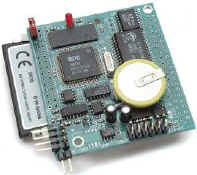 Additional features
Additional features
The FB offers 8 channels of high-precision 16-bit ADC. In comparison to some of the other ADCs offered on our controllers, the ADS8344 is especially remarkable because of the very low noise detected. The ADS8344 can be accessed at around 20 Ksamples/second, and has an input voltage range of 0-5V.
The FB also has a total of 4 channels of 12-bit DAC (DAC7612) available onboard. The output voltage range on the DAC is at 0-4.095V, and each channel is capable of sinking/sourcing up to 5 mA.
Important to customers that wish to deploy the FB in special environments, an ultra-low quiescent current (35 uA), low-drop voltage (85 mV) regulator (TPS76550, TI) can be installed. It allows operating power input of low as 5.1V (while the linear regulator requires at least 9V). It can yield significant improvement in operating life for battery-powered applications. You can also shut down the regulator with a TTL pin, reducing the quiescent current to as low as 1 mA.
Compact-Flash Access
Very importantly, the FC can also be pre-configured with a simple serial (or TTL) interface that allows you to access the data storage capabilities of the board without using TERN development tools to program the application. This means you can add the mass data storage capabilities of this board to your existing system without having to learn yet another embedded development environment. Instead, you can interact with the board as a simple menu-driven serial device. With one serial command, begin dumping serial data into a file. With another, read that file back over the serial port.
By using the FlashCore, users can easily add widely used CF standard mass data storage cards to their embedded application via RS232, TTL I2C, or parallel interface. TERN supports a complete C/C++ programmable software package (EV-P, or DV-P kit) which includes compiler, remote debugger, samples, and libraries. TERN software supports Linear Block Address mode, 16-bit FAT flash file system, RS-232, TTL I2C or parallel communication.
Flash File System
Flash memory disks can be formatted with a PC-compatible FAT-12/FAT-16 filesystem. This allows them to be accessed as normal drives on any ordinary PC with a PCMCIA/CompactFlash port; users can access files on the Flash disk as easily as any file on the hard-drive.
The use of FAT16-formatted CompactFlash cards allow you to take full advantage of this format of physical media:
- when inserted into a PC, the card looks just like any other drive; create/read/write files directly onto the drive.
- when the CF card is accessed from the TERN controller, you can create/read/write on top of the same files.
A new suite of software libraries makes it possible for you to directly access this filesystem from your embedded device, as well. By using TERN boards offering access to Flash memory devices (the FlashCore and Memcard-A), your embedded application can open, read, write, and delete files.
Performance wise, the 8-bit controllers (such as the FB) can read from a file at approximately 400 KB/second, while writing at a peak rate of 500+ KB/s. 16-bit controllers have slightly better performance.
The filesystem libraries can also be used for easy firmware upgrades. A .hex file (generated using the Paradigm C++ environment) stored on the CF card can be programmatically loaded into SRAM and executed. This allows the update/replacement of firmware through many mechanisms: user update (just by copying a file), ethernet transfer, serial port, etc..
Now, the TERN filesystem can also be directly accessed through the serial port without requiring the rest of the TERN development environment. A simple menu-driven interface for accessing the file-system can be directly programmed into the on-board Flash. You can add embedded data storage capability to your embedded application for the price of a single FlashCore.
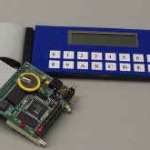 Keypad/LCD Interface
Keypad/LCD Interface
The FB can also be easily interfaced with a Kpad-IO expansion board through a ribbon cable, which provides a 16×2 character-based LCD and 8×2 keypad. For details of this interface, see Appendix C of the FB technical manual.
- Measures 2.1×2.35×0.7 inches
- 16-bit CPU (188), x86 compatible
- 40 MHz system clock
- 32 I/O lines from CPU
- 512 KB ACTF Flash
- up to 512 KB battery-backed SRAM
- 512 bytes serial EEPROM
- 8 external interrupt inputs
- 3 16-bit timers/counters
- 2 RS-232 serial ports, 5V regulator
- Real time clock, battery
- 8 ch. 16-bit ADC (ADS8344, 20 KHz)
- 4 ch. 12-bit DAC (DAC7612, 0-4V)
- Ultra-low quiescent current, low-drop voltage regulator.
Comparison:
The FlashCore-B is a newer variant of the original FlashCore controller. It offers special support for low-power operation, and has powerful analog I/O support. Very importantly for OEM manufacturers, the FB also has improved mechanical features that makes accessing the CompactFlash card more easily.
Just as the original FlashCore, the FB is also available as an expansion board for other TERN controllers. The FC-0 ($49, quant. 1) makes the CF interface available to any controller with an exposed J1 (address/data bus) header.
The Ethernet-Engine is similar to the FlashCore-B, except with onboard Ethernet + USB capability. TheFFlashCore-N control board is also similar, but adds up to 8 additional UARTs (4 RS232).
The MD88 controller is a useful core controller for applications requiring high-voltage solenoid drivers.
- Includes 188 processor 40 MHz with 128 KB SRAM
- 32 I/Os
- 2 RS232/UARTs
- 3 timers
- watchdog timer
- 512 byte EE
- ACTF flash
- 5V linear regulator
- CompactFlash interface
- Does not include add-on options
- OEM option discounts available
- Ask about ejector mechanism
| Quantity | Price |
|---|---|
| 1 | $99 |
| 100 | $79 |
| 1,000+ | $34 |
Add-on Options:
| No. | Options | Price |
|---|---|---|
| 1 | SRAM: 512KB | $20 |
| 2 | Real-time clock and battery | $20 |
| 3 | 8 ch. 16-bit ADC (ADS8344) | $30 |
| 4 | 2 ch. 12-bit DAC x2 | $20×2 |
| 5 | Low-power version (20 MHz TPS76550) | $20 |
| 6 | CompactFlash cards (8 MB – 1 GB) | call |
Related Products

